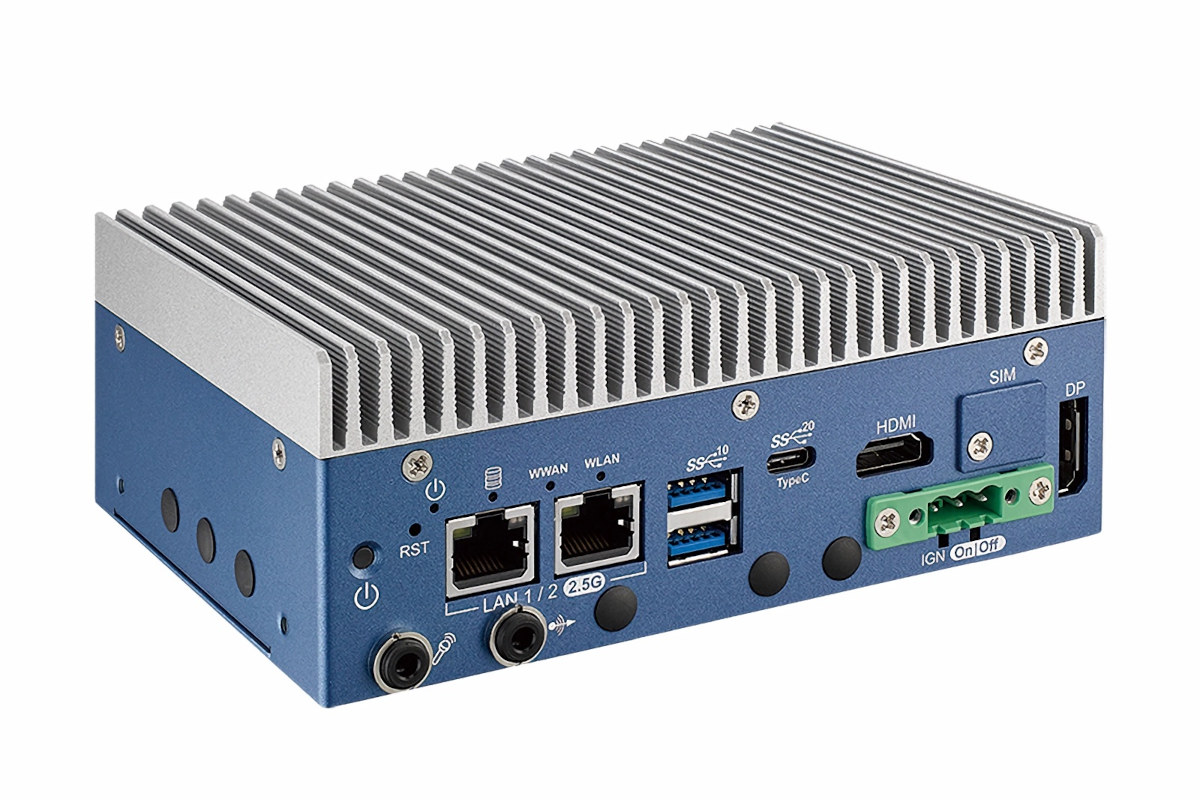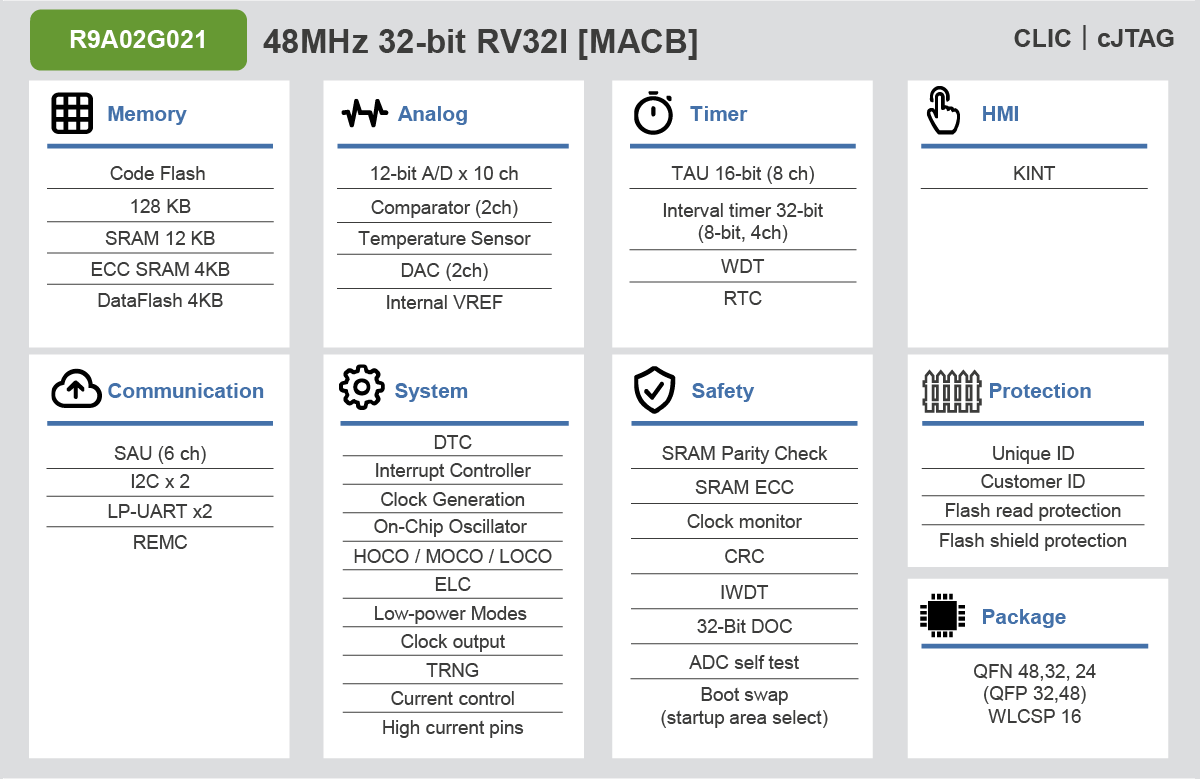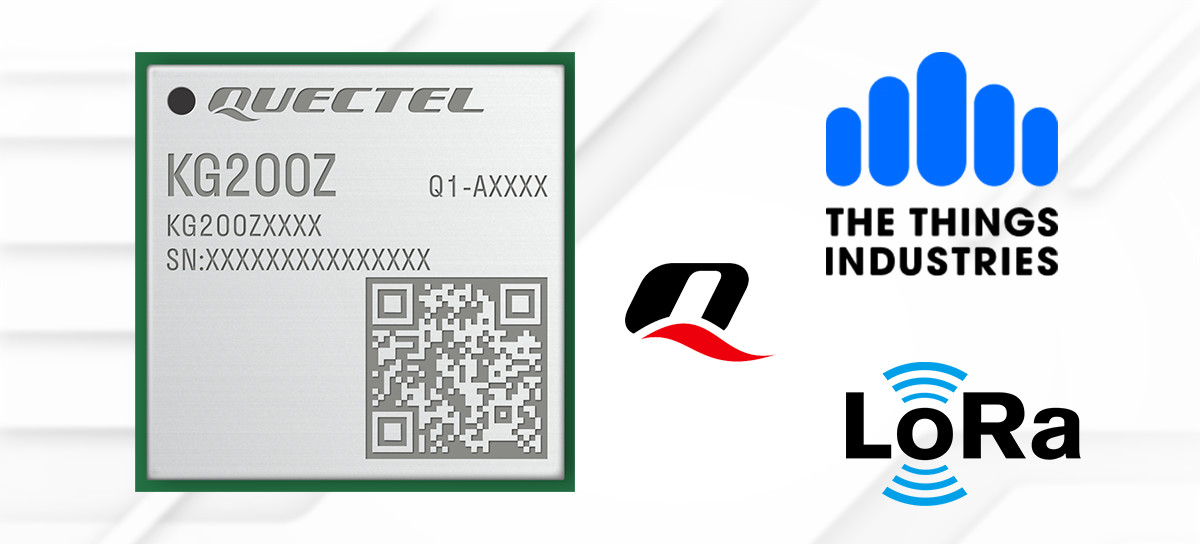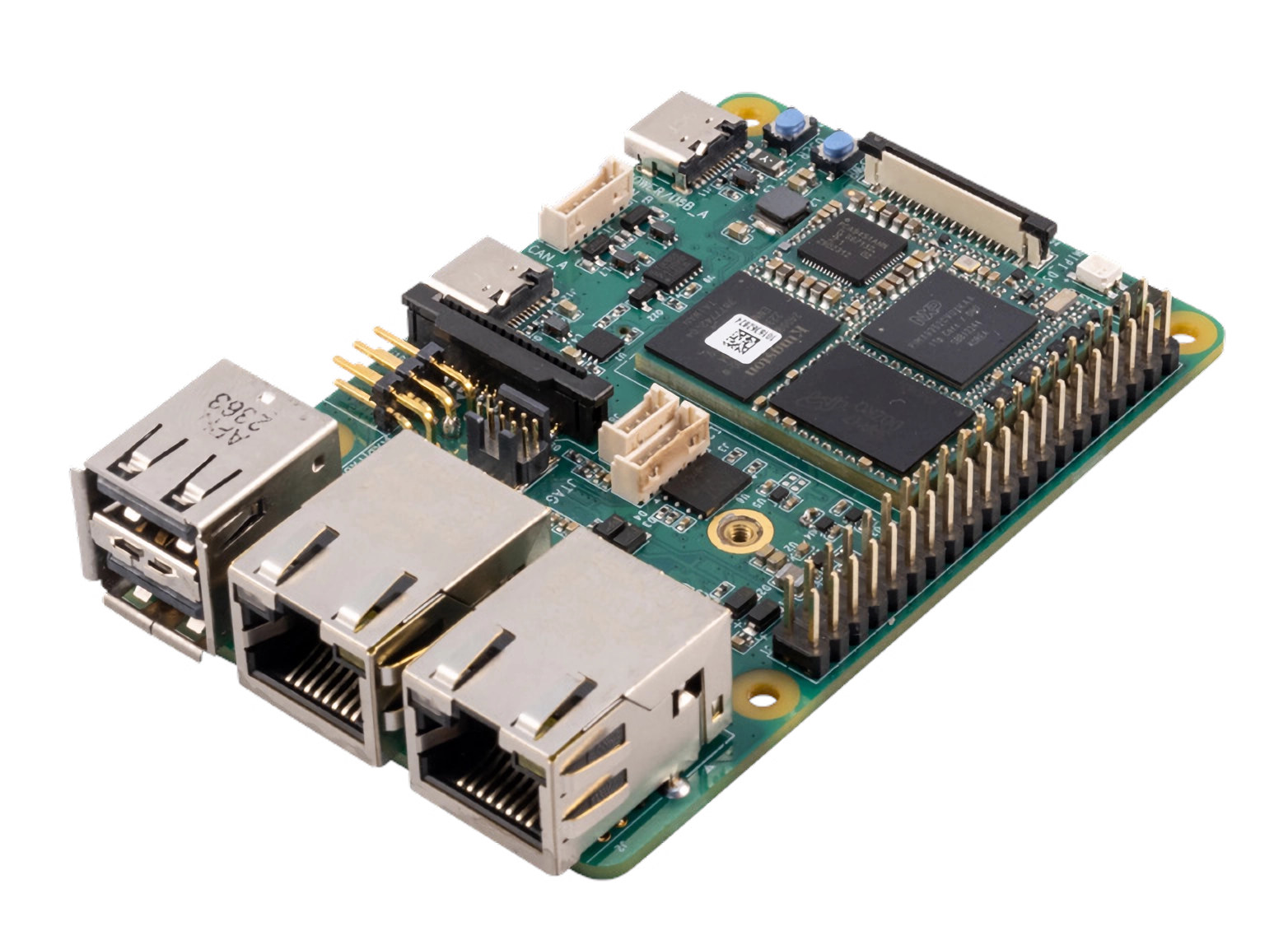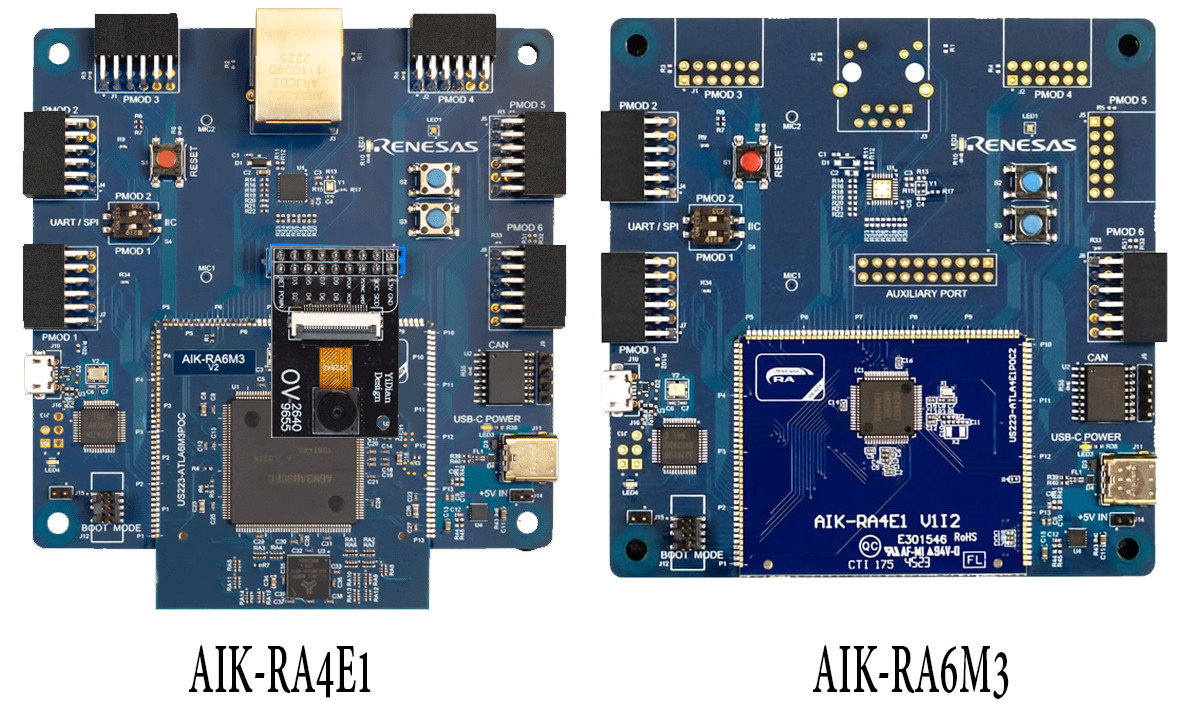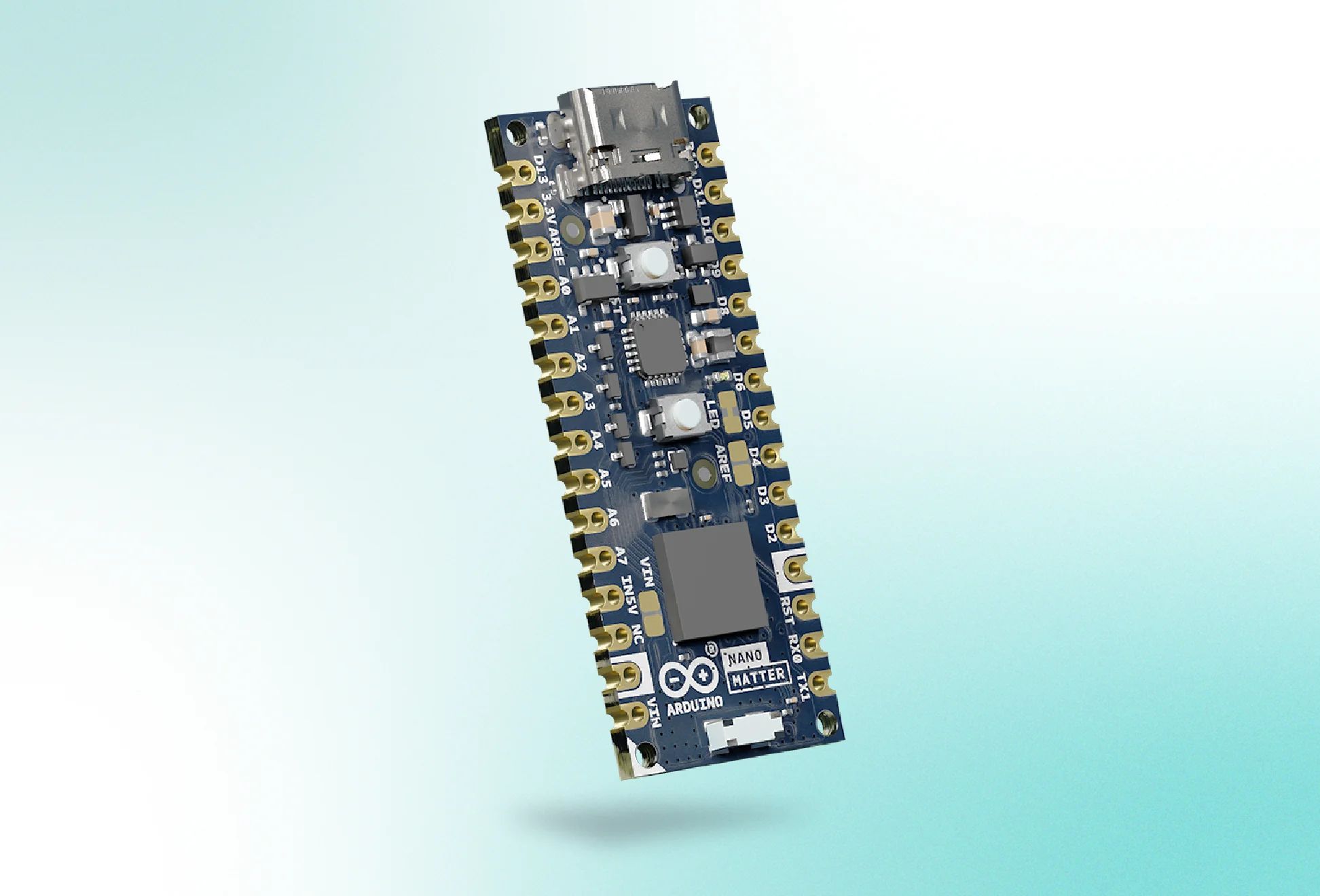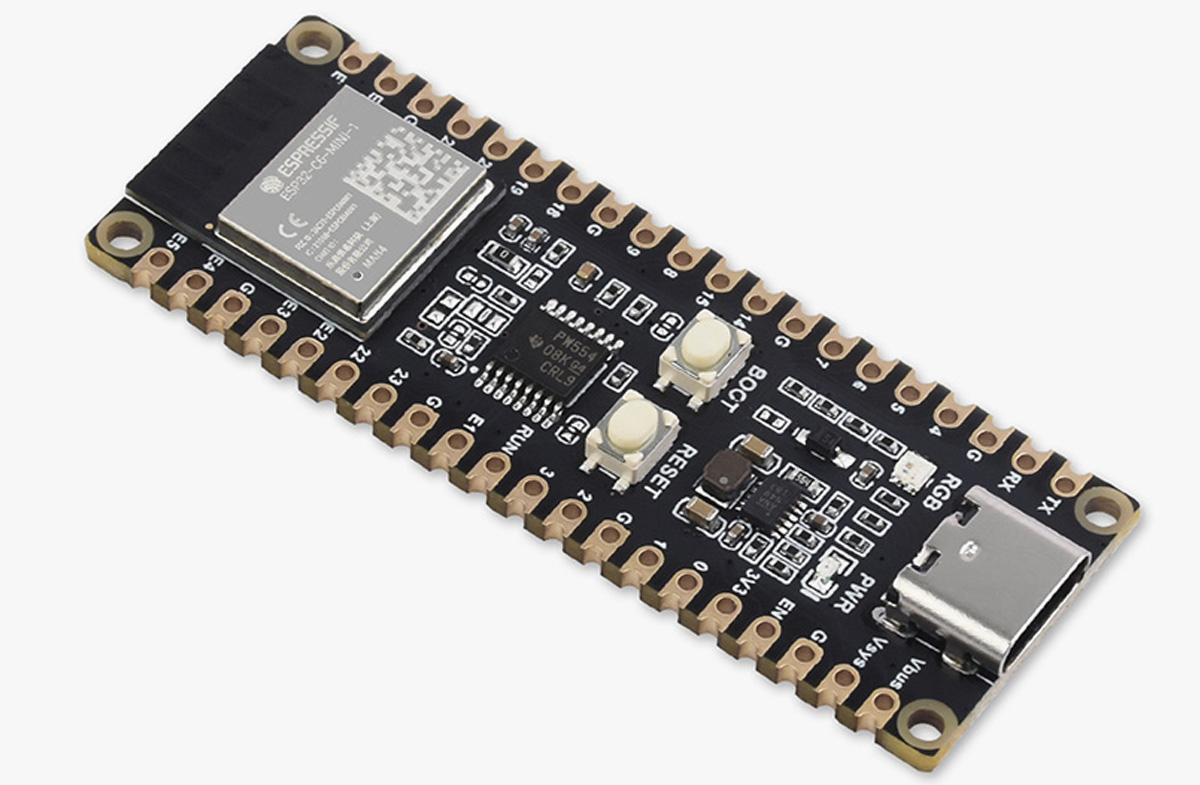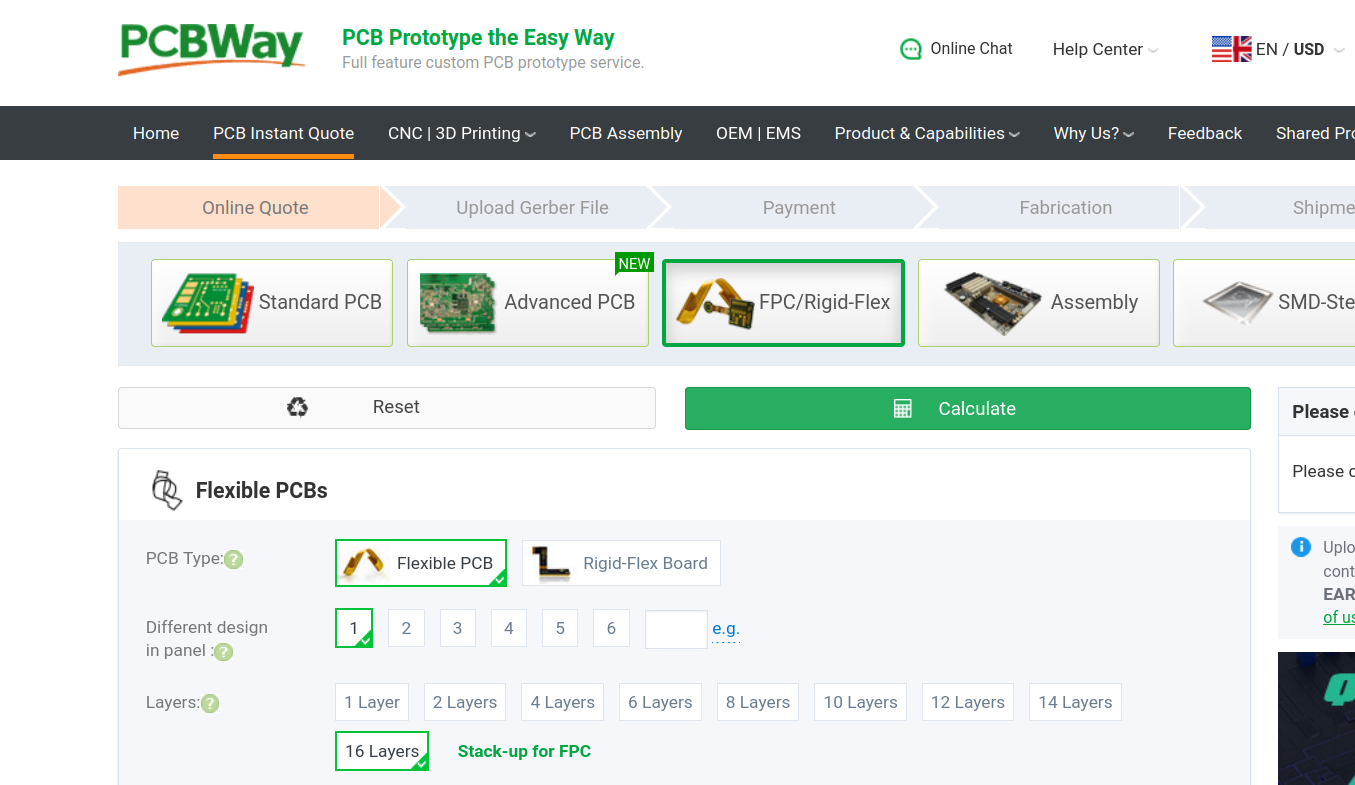Vecow SPC-9000 fanless embedded system is powered by the 14th Gen Intel Core Ultra 7 165U or Core Ultra 5 135U 12-core Meteor Lake processor and targets Edge AI applications for factory management, data acquisition & monitoring, autonomous mobile robots (AMR), Smart Retail, and more. The device supports up to 32GB DDR5 RAM, offers M.2 PCIe sockets and a 2.5-inch SATA bay for storage, can drive up to three 4K displays through HDMI, DP, and USB-C ports, features two 2.5GbE ports, and a few USB ports. The SPC-9000 can also be fitted with a 4G LTE module, comes with two RS232/422/485 serial ports, takes a wide 9V-55V DC input voltage range, and can operate up to a -40°C to 75°C temperature range depending on the model. Vecow SPC-9000 specifications: Meteor Lake SoC (one or the other) Intel Core Ultra 7 165U 12-core (2P+8E+2LPE) processor @ 1.2 / 1.7 / 4.9 […]
R9A02G021 is the first microcontroller with Renesas 32-bit RISC-V CPU core design
Renesas R9A02G021 is the first MCU group to use the company’s in-house designed 32-bit RISC-V CPU core with 3.27 CoreMark/MHz, RV32I base plus M/A/C/B extensions, and features such as a stack monitor register, a dynamic branch prediction unit, and a JTAG debug interface. Renesas has been making RISC-V chips at least since 2022 with the likes of RZ/Five 64-bit microprocessor and R9A06G150 32-bit voice control ASSP. All those were based on Andes RISC-V cores, but since the company has now designed its own 32-bit core, future Renesas 32-bit RISC-V microcontrollers are all likely to feature the in-house core, starting with the R9A02G021 general-purpose MCU group. Renesas R9A02G021 key features and specifications: RISC-V Core Renesas RISC-V instruction-set architecture (RV32I + MACB + Ziscr, Control and Status Register (CSR) instructions + RISC-V Zifencei Instruction-Fetch Fence) Maximum operating frequency – 48 MHz Debug and Trace – RISC-V External Debug Support cJTAG Debug Port […]
Quectel KG200Z LoRa module is now secured by The Things Stack
In January of this year, Quectel launched the KG200Z LoRa Module, an Arm Cortex-M4-based module boasting a self-proclaimed range of 2-5 kilometers in urban settings and 10-15 kilometers in suburban areas. At that time, it was just another LoRa module with some additional features. However, in the latest development, Quectel and The Things Industries have announced a partnership that ensures this LoRa module comes integrated with “Works with The Things Stack” and “Secured by The Things Stack” certifications, enhancing its value and utility. In simpler terms, it’s been tested and proven to operate smoothly within The Things Stack ecosystem. Earlier this year, we saw STMicro and Particle Industries release their LoRa-based modules and devices. Feel free to check those out if you are interested. KG200Z LoRa Module Specification: Arm Cortex-M4-based standalone LoRa module (STM32WL) Frequency support – 470–510MHz and 862–928MHz bands Low power – 1.7 μA in deep sleep mode […]
MaaXBoard OSM93 – Business card-sized SBC features NXP i.MX 93 AI SoC, supports Raspberry Pi HATs
MaaXBoard OSM93 is a single board computer (SBC) based on a Size-S OSM module powered by an NXP i.MX 93 Cortex-M55/M33 AI SoC and offered in a business card form factor with support for Raspberry Pi HAT boards through a 40-pin GPIO header and mounting holes. The board also comes with 2GB LDDR4, 16GB eMMC flash, MIPI CSI and DSI interfaces for optional camera and display modules, two gigabit Ethernet ports, optional support for WiFi 6, Bluetooth 5.3, and 802.15.4, three USB 2.0 ports, and two CAN FD interfaces with on-board transceivers. MaaXBoard OSM93 specifications: SoC – NXP i.MX93 CPU 2x Arm Cortex-A55 up to 1.7 GHz 2x Arm Cortex-M33 up to 250 MHz GPU – 2D GPU with blending/composition, resize, color space conversion NPU – 1x Arm Ethos-U65 NPU @ 1 GHz up to 0.5 TOPS Memory – 640 KB OCRAM w/ ECC Security – EdgeLock Secure Enclave System […]
Renesas AIK-RA4E1 and AIK-RA6M3 reference kits are designed for accelerated AI/ML development
Renesas AIK-RA4E1 and AIK-RA6M3 are two new development boards based on RA-series 32-bit microcontrollers. These new dev boards have multiple reconfigurable connectivity functions to accelerate AI and ML design and development time. Both boards appear similar, but the AIK-RA4E1 uses the R7FA4E110D2CFM MCU, features three Pmod ports, and has no Ethernet support. On the other hand, the AIK-RA6M3 utilizes the R7FA6M3AH3CFC MCU, has six Pmod ports, and includes Ethernet support. Both the boards support full-speed USB and CAN bus. Renesas AIK-RA4E1 and AIK-RA6M3 reference kits specifications (Consolidated): RA4E1 Microcontroller Features: Model: R7FA4E110D2CFM Package: 64-pin LQFP Core: 100 MHz Arm Cortex-M33 SRAM: 128 KB on-chip Code Flash Memory: 512 MB on-chip Data Flash Memory: 8 KB on-chip RA6M3 Microcontroller Features: Model: R7FA6M3AH3CFC Package: 176-pin LQFP Core: 120 MHz Arm Cortex-M4 with FPU SRAM: 640 KB on-chip Code Flash Memory: 2 MB on-chip Data Flash Memory: 64 KB on-chip Connectivity: One USB […]
Arduino Nano Matter board specifications and price announced
The Arduino Nano Matter is the product of a collaboration between Arduino and Silicon Labs. The Nano Matter board was announced in January and is powered by SiLabs’ MGM240S chip. It offers multiple wireless connectivity options such as Matter, OpenThread, and Bluetooth Low Energy. Support for the Matter standard is the Nano Matter board’s key offering. Matter is an open-source, connectivity protocol that lets smart home devices from different manufacturers interoperate seamlessly. The 45mm x 18mm board leverages dual-mode connectivity, with IEEE 802.15.4 (Thread) for mesh networking and Bluetooth Low Energy for short-range communication. It is targeted at the Internet of Things, home automation, professional automation, environmental monitoring, and climate control applications. Prospective industrial applications include machine-to-machine interoperability, machine status monitoring, and worker status optimization. Arduino Nano Matter specs: MPU – SiLabs MGM240SD22VNA MCU core – 32-bit Arm Cortex-M33 with DSP (digital signal processing) instruction and FPU (floating-point unit) @ […]
$6.99 Waveshare’s ESP32-C6-Pico Board resembles Raspberry Pi Pico board
Waveshare’s ESP32-C6-Pico and ESP32-C6-Pico-M development boards are equipped with the ESP32-C6-MINI-1 module supporting Wi-Fi 6(802.11ax), Bluetooth 5, Zigbee 3.0, and Thread 1.3, and inspired by the Raspberry Pi Pico form factor. They can be powered either through USB Type-C or an external 5V DC supply connected to the pins. Previously we have written about similar ESP32-C6-based boards like the SparkFun Thing Plus, ePulse Feather C6, and WeAct ESP32-C6 dev board. However, these boards are priced way over the $6.99 that Waveshare is offering. One exception is the DFRobot’s FireBeetle 2 ESP32-C6 board, which cuts costs by using the IC directly instead of the fully shielded ESP32-C6-MINI-1 module. Waveshare’s ESP32-C6-Pico board specifications: Wireless module – ESP32-C6-MINI-1 SoC – ESP32-C6H4 32-bit RISC-V microprocessor up to 160 MHz with 320KB ROM, 512KB HP SRAM, 16KB LP SRAM, 4MB flash Wireless – 2.4 GHz WiFi 6 with Target Wake Time (TWT) support, Bluetooth 5.3 LE and […]
PCBWay adds new parameters to its flexible PCB manufacturing services (Sponsored)
PCBWay, one of the most popular PCB manufacturers in China, has been offering flexible PCB manufacturing services for years, but the company has recently added new parameters and special processes to its flexible PCB ordering page. The first change is that customers can now order more complex flexible PCBs with up to 16 layers when using Polyimide Flex base material. PCBWay also added support for “high-frequency (DK<=3.6)” material with a dielectric constant of under 3.6 at 1 MHz as well as “Transparent” and “Translucent” options for PET material in the Polyimide base material section. Additional FPC thickness options have also been introduced with 0.025 and 0.05mm for one-layer boards and 0.08mm for two-layer boards enabling ever-thinner designs. Customers have now more choices when ordering stiffeners – the rigid part of a FlexPCB – with the “TOP Black FR4” and “BOT Black FR4” options with thickness options including 0.2mm, 0.4mm, 0.5mm, […]


